They were every little kid’s dream, at least every little kid who longed to be behind a motion picture or television camera. Riding a huge camera crane as it soared through the air from a high and wide position down to ground level and into a close-up of a beautiful actress, all in one sweeping move.
Camera cranes are relegated to specialty use now. With the invention of the Louma crane and the Technicrane, they were replaced by robotic jib arms or computer controlled units that could repeat the same move over and over again. Then, as cameras got smaller and smaller and video replaced film, the miniaturization of high quality cameras made the need of a person operating a camera thirty feet in the air unnecessary. Today, with the proliferation of drones, the days of land based cranes of any sort may be numbered.
A crane shot is one that allows the camera to move through space in any direction – up, down, left, right, forward or backward. Over time, the equipment to accomplish crane shots improved dramatically. Those first cranes required many wranglers to accomplish a shot. Now, an operator using a drone can accomplish amazing views that move the camera through, over and around objects like no crane could ever do.
Yet the camera crane still remains with us. A quick visit to the website of Chapman-Leonard Studio Equipment reveals a busy system of state of the art camera support units modernized to accommodate films and television in today’s world.
It is generally accepted the first crane shot came in 1916 on the D.W. Griffith spectacular silent film Intolerance. It is believed no pictures of the apparatus have survived. While the film is a Giffith production, the execution of the shot was conceived by fellow director, Allan Dwan, an ex-inventor and ex-engineer before getting involved with directing films.
“I had nothing at all to do with the making of Intolerance,” Dwan told Kevin Brownlow in 1964 for his book “The Parade’s Gone by.” Griffith’s cameraman Billy Bitzer, “came to me and said, ‘The boss wants to know if you’d mind talking with me about a problem we’ve got – because he knows you’re an engineer.’”
Griffith wanted to be able to rise to the top of the colossal Babylonian set and then descend to ground level again. The shot also moves closer to the set and retreats. According to David Samuelson who has written extensively on camera mobility in his books and for the American Society of Cinematographers, “The details of how these shots were accomplished have been lost in antiquity.
However. in Brownlow’s book, Dwan goes on to describe the device he designed to accomplish the look Griffith and Bitzer wanted. Dwan’s description supports Samelson’s theory of “a large tower spanning two railway wagons.”
According to Dwan, they would “…construct a device on a railroad track with an elevator in it. The device was very simple, built of tubing so it could easily be dismantled and put together. I designed the ideal of what to work for and suggested the use of railroad tracks, made utterly smooth so there would be no vibration, and railroad wheels.” The shot left audiences of the film reacting with audible gasps and left them in total wonder.
In 1929, Paul Fejos along with cameraman Hal Mohr, shot a brooding story of gangsters and chorus girls titled “Broadway” for Universal Pictures. Unlike the lighthearted romps the likes of Busby Berkley that would come later, Fejos’ film was a mix of murders and mob activity in a nightclub punctuated by huge scale dance numbers. Dave Kehr reviewed the films from the Criterion Collection release in 2012 for the New York Times. His observation of Fejos’ work on the adaptation of the stage hit was less than enthusiastic.
“Fejos seems barely engaged with the trite, backstage story of gangsters and chorus girls, devoting his attention instead to the film’s true star: the gigantic, 50-foot camera crane that he had built to cover the cavernous nightclub set that is the film’s central location.”
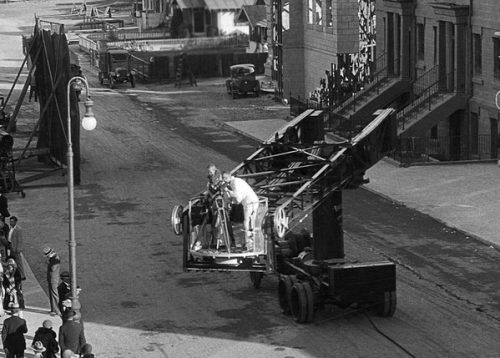
From the Motion Picture Photography: A History, 1891-1960, it was “built by the Llewelling Iron Works at a cost of $50,000, it had boom 45 feet long and weighed 28 tons.” The crane, as many others were, was referred to as a “one-off.” As Samuelson goes on in his October, 2003 and March, 1999, ASC articles, “Thereafter, most studios had their own camera cranes.” “For the next 50 years or so,cranes were of the one-off variety or owner-user jobs, each one bigger and heavier than the last.”
As Kees van Oostrum, ASC, said in the June, 2017, American Cinematograher, all the cranes of the day were “massive things mounted on trucks and carrying three people and a heavy camera… In the beginning, the cranes looked more like small cars that were moved on planks – heavy equipment that was at odds with the need for a smooth landing on a close-up.”
Cranes adopted designs born out of a specific purpose – to satisfy the need to obtain a shot the filmmaker had in his head. By looking at the variety of designs in production stills, the cranes came in all shapes and sizes and were unique in some way. An example of this is Hitchcock’s contraption to get a shot for his film Notorius.
The rig was completely constructed out of wood. The camera moves from the wide view of the huge staircase down to Claude Rains and Ingrid Bergman engaged in conversation. But it doesn’t stop there. It continues right into a close-up of Bergman self consciously fidgeting with the key in her left hand. According to Matt Buchholz on his 2016 blog about Notorious, this was Hitchcock’s best version of macro-to-micro. “The shot establishes a scene, sets a tone, builds suspense and communicates plot all in one moment.”
Very rarely would cranes be taken on location. Upon occasion, exceptions would be made. The “Broadway” crane, designed to be used on the stage or backlot, was transported to the Irvine Ranch location of All Quiet on the Western Front (1930). Irvine is over fifty miles from the Universal stages where the production of Broadway was shot.
Cranes for Busby Berkley, mentioned above, were particularly important in his musical routines in the 1930’s. He used cranes that allowed the camera to move through the sets with the music of the orchestra while photographing the beautiful women and handsome men who adorned them.
This was the norm for over 20 years. But each crane having its own special use was about to change. Chapman Studio Equipment began operations in 1945. Later, in 1965, they teamed with Leonard Studio Equipment. That name lives on through to today as its line of top quality and specialized production support equipment continues to be designed and built in its San Fernando Valley location.
As Samuelson tells it, “After World War II, Ralph Chapman, a special effects technician with an engineering bent, produced the first studio crane that was more than a one-off.” The Chapman line of equipment began with small, medium and large stage cranes developed between 1946 and 1947. Of the large cranes, the biggest of them were able to get the camera mount up to forty feet off the stage floor.
About 1950, Chapman developed a crane than could travel independently. The cranes were equipped with gasoline engines so they could be taken to the location under their own power. The unit was mounted on a chassis that could also run on a silent electric motor drive for use on sets using recording takes using sensitive sound equipment.
On gasoline, it could travel anywhere. No longer confined to the sound stage, it could travel with the production and shoot exteriors from city streets to deserts and mountains. And wherever the set was they could be set up to do all the things they had been doing on the stage or backlot including a six-wheel crab ability.
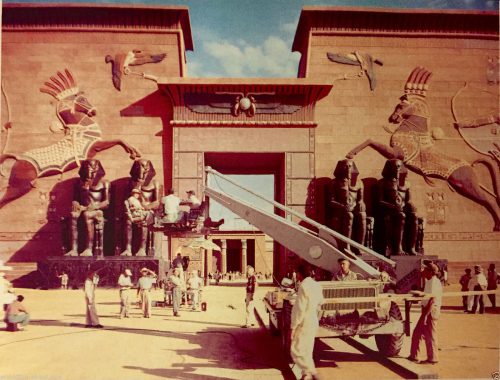
Chapman built the crane for Demille’s Paramount production of The Greatest Show on Earth (1950) and his re-make of The Ten Commandments (1952), One of first “road trips” that took the unit out of Hollywood was for Demille’s circus extravaganza when it was used to film actual circus performances in Washington, DC.
After the success of the device, Chapman improved upon his design and developed it into product named “Hercules.” Not just the domain of the studios anymore, the units were available for hire by anyone.
One of Chapman’s early achievements was the first automatic leveling location crane. On sound stages this wasn’t a huge problem. But on uneven terrain on location, it became imperative. According to a sales advertisement to sell the original Hercules boom arm movement, it would seem that Chapman had the automatic leveling device in place so Demille was able to use it on the Ten Commandments. It is hard to decipher for sure what is in place from pictures available from the set. None the less, Chapman’s equipment quickly became essential equipment due to its top quality and specialized camera movement.
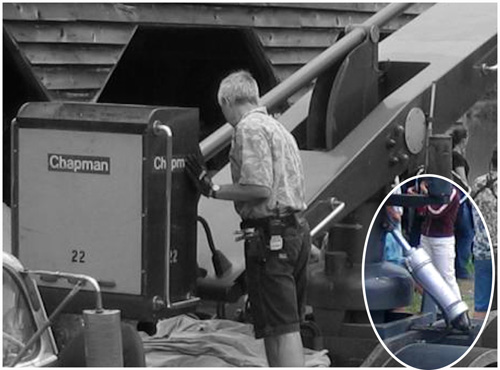
In 1961, Chapman introduced the Chapman Titan crane. This was a major improvement over all previous support gear. It has a reach of 17 feet and a lens height of 27 feet (37 feet with it’s camera riser mounted). The system also carried more than just a camera and an operator. It can handle the director, an assistant cameraman and an operator for the two brute arc lamps that could be mounted on board.
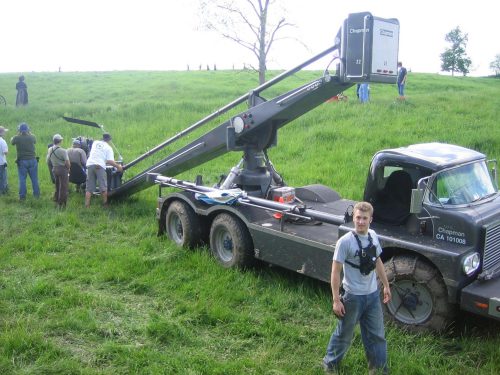
Because Chapman cranes were leased, all were returned to their manufacturing point and retrofitted and/or upgraded to new developments. The company continued to make their entire inventory state of the art and took advantage of all safety features as they became available.
In the meantime, television was catching on. Music and dance numbers were a popular staple with early TV viewers. Directors could see that moving their electronic cameras around on a crane would supply another view for live cameras. In the late forties and early fifties, the Sanner and Houston-Fearless units provided stage support. But shortly Chapman-Leonard became the name to call for television’s needs for entertainment and eventually sports on and off the stage.
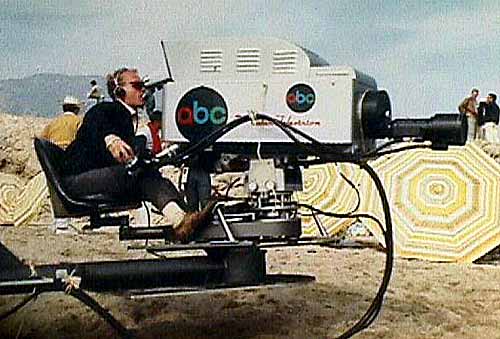
Cut to 1970. In France, Jean-Marie Laalou and Alain Masseron needed to shoot inside a submarine. They wanted to do a tracking shot the length of the ship with the camera passing through bulkheads amongst crewmembers and equipment. When they succeeded, a whole new version of camera crane arrived – the concept of the remote controlled camera crane. Samuelson, writing about the unit in the ASC Magazine in March, 1999, described it as fitting “a Camflex camera on a gyroscopic pan-and-tilt head at the end of a long pole, which, in turn, was on a tripod mounted to a narrow Elemack dolly.” Later, Samuelson would market the units throughout Europe.
In the intervening years, the project was refined and upgraded. Now dubbed the “Louma” crane, they added “an electronic remote-controlled head and a lightweight video assist” and the “modular remote-control camera crane was born.” In 2005, the Motion Picture Academy bestowed their Technical and Scientific Achievement Awards on Lavalou, Masseron and Samuelson for the Louma remote-controlled camera head.
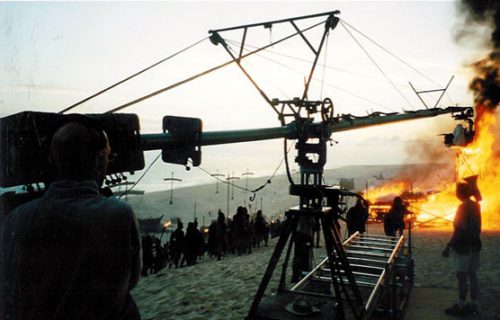
Also receiving an award at the same time was Horst Burbulla, creator of the Technocrane telescoping camera crane. Technocrane allowed the arc of the crane to be compensated for by retracting or extending the boom making the moves in straight lines rather than in arcs.
From the Louma, came various designs, particularly with video. Television cameras were shrinking in size while the quality was increasing inversely. Large cranes to support television cameras and their operators became a specialty only the networks and larger stations could afford. The jib arm has become the standard piece of equipment affordable by even the smallest local station.
As film began to fade from the production scene, electronic cameras grew closer to replacing the quality of their emulsion-based counterpart. This, together with their shrinking size, made them workhorses for both theatrical and television production. With rental rates on a portable jib set up at $150/day, renting from a company like Stray Angel Films can provide the same wide, sweeping movement on any project you choose and it only takes five minutes to assemble!
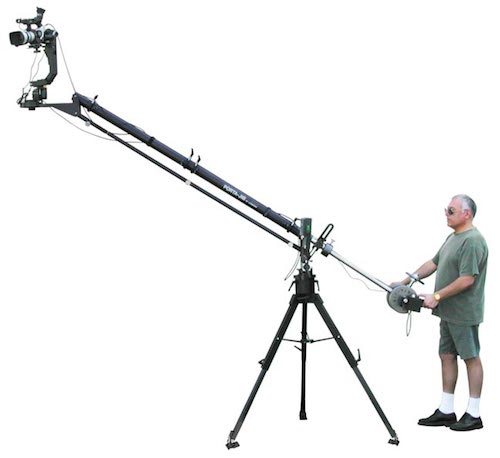
In the world of live television we have cameras streaking across a football field hung on cables just a few feet above the players. Multi-camera equipment compliments on television shows make regular use of a jib arm using it in place of a crane. Cameras on feature productions use computer control to repeat shots over and over again no matter whether they are on a stage or on location.
But you’ll still see manually operated cranes here and there. Places like Saturday Night Live has a Chapman Nike Electra on the show whenever it shoots. Watch the NFL and you’ll see cameramen riding the sidelines. Features still shooting on film will bring in a Chapman Titan to get a look they cannot get from the electronic units.
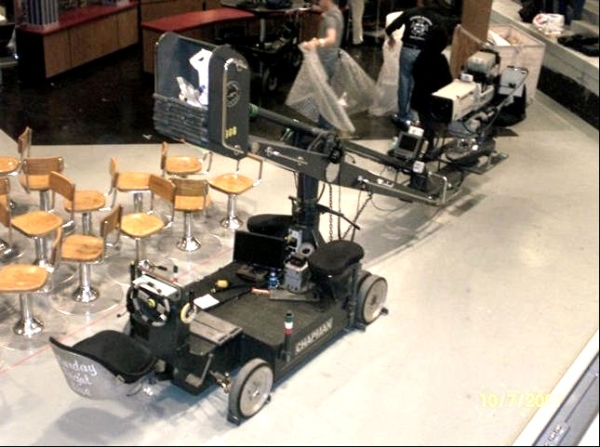
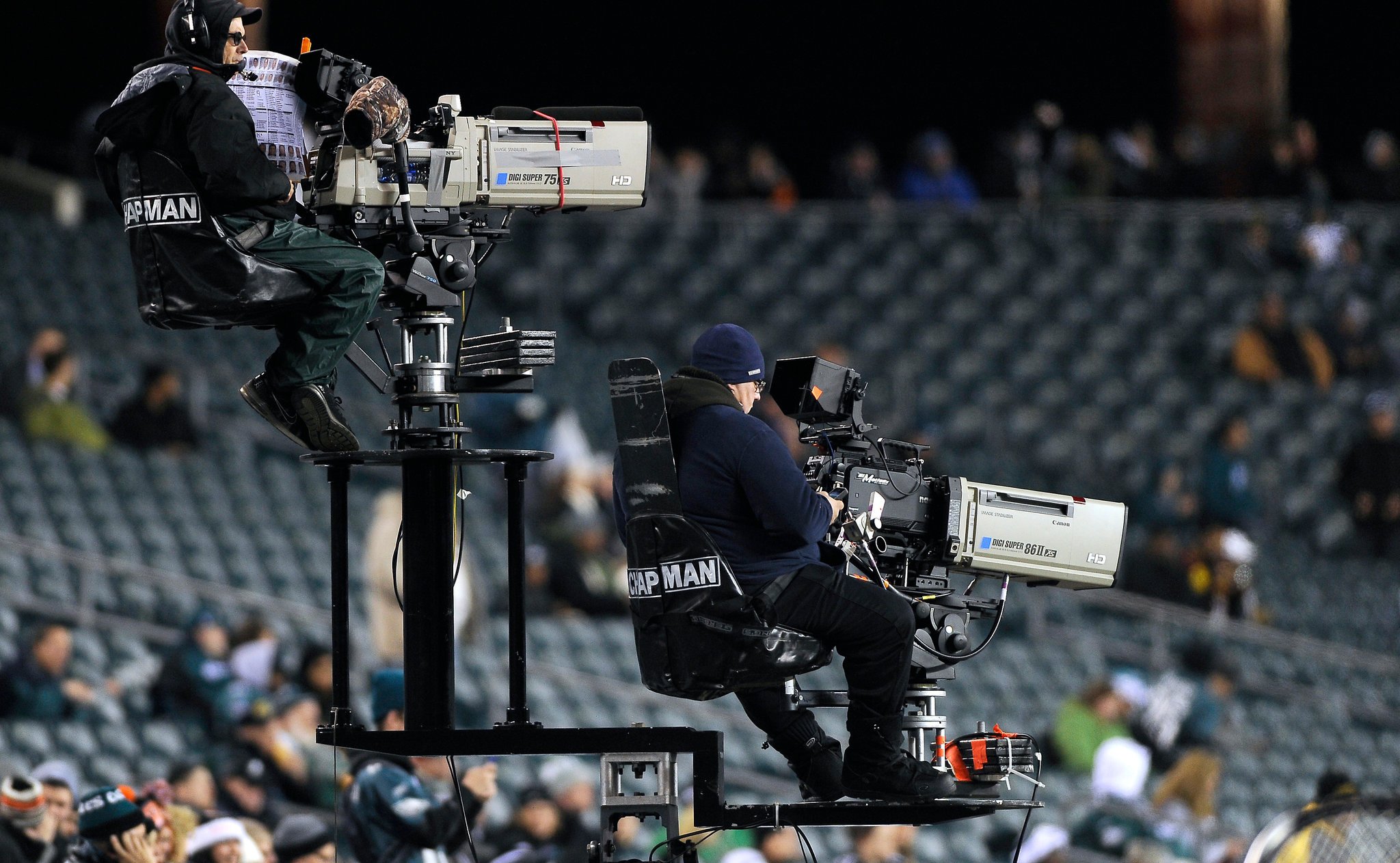
Will there ever be a day come where cranes are not needed anymore? I think not. Cranes have provided a long history of steady camera movement sweeping across a set in dead silence. I prefer to think they will remain another one of those solutions filmmakers go for when searching their toolkit. After all, the kid won’t be satisfied until they get to “ride the crane!”

Filmtools
Filmmakers go-to destination for pre-production, production & post production equipment!
Shop Now













